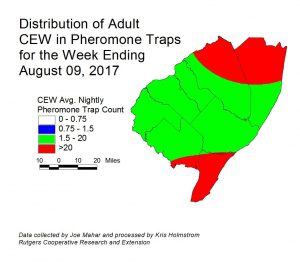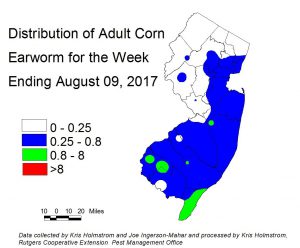Note: Due to technical difficulties, only sweet corn related maps and information will appear in this edition of the IPM Update. We hope to resume full coverage next week.
Kris Holmstrom and Joe Ingerson-Mahar
Sweet Corn
European corn borer (ECB) adult numbers have again subsided, and no map will appear here. As with last year, the second flight of ECB in New Jersey is low and sporadic. While we are beginning to see limited feeding from this pest, it is relatively insignificant compared to fall armyworm (FAW) feeding that is now occurring on whorl stage sweet corn. Insecticide applications should be made when 12% or more plants exhibit signs of ECB and/or FAW feeding. FAW is, and will remain the dominant pest of vegetative stages of sweet corn for the remainder of the season. Damage is extensive in the southern most counties, while it has increased only slightly over the past week in central and northern NJ.
Corn earworm (CEW) catches have gotten slightly more consistent in blacklight traps around the southern half of the state, while pheromone trap catches have risen dramatically in some areas (see CEW blacklight and pheromone trap maps). Growers now treating silking sweet corn should adhere to silk spray schedules to limit damage.
The following are recommended silk spray schedules by region:
South – 3 days
Central – 4-5 days
North – 5-6 days
With frequent rains, the incidence of rust is increasing in some sweet corn plantings. Additionally, northern corn leaf blight has also been discovered in the northern counties. These diseases can be economically significant, particularly if they first appear in whorl stage plants. Should this situation occur, growers need to consider fungicide applications to limit damage. See the latest Commercial Vegetable Production Recommendations for suitable fungicides on this crop. 


